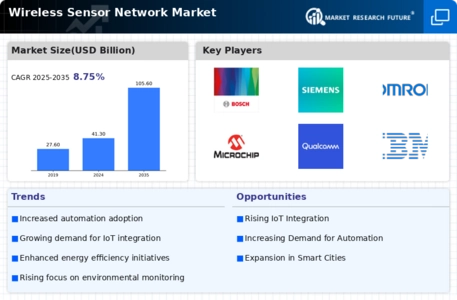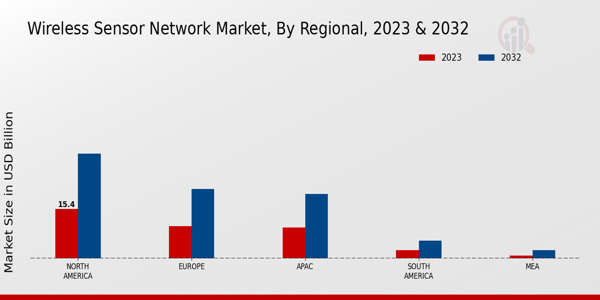-
EXECUTIVE SUMMARY
-
Market Overview
-
Key Findings
-
Market Segmentation
-
Competitive Landscape
-
Challenges and Opportunities
-
Future Outlook
-
MARKET INTRODUCTION
-
Definition
-
Scope of the study
- Research Objective
- Assumption
- Limitations
-
RESEARCH METHODOLOGY
-
Overview
-
Data Mining
-
Secondary Research
-
Primary Research
- Primary Interviews and Information Gathering Process
- Breakdown of Primary Respondents
-
Forecasting Model
-
Market Size Estimation
- Bottom-Up Approach
- Top-Down Approach
-
Data Triangulation
-
Validation
-
MARKET DYNAMICS
-
Overview
-
Drivers
-
Restraints
-
Opportunities
-
MARKET FACTOR ANALYSIS
-
Value chain Analysis
-
Porter's Five Forces Analysis
- Bargaining Power of Suppliers
- Bargaining Power of Buyers
- Threat of New Entrants
- Threat of Substitutes
- Intensity of Rivalry
-
COVID-19 Impact Analysis
- Market Impact Analysis
- Regional Impact
- Opportunity and Threat Analysis
-
WIRELESS SENSOR NETWORK MARKET, BY APPLICATION (USD BILLION)
-
Industrial Automation
-
Environmental Monitoring
-
Healthcare
-
Smart Agriculture
-
Home Automation
-
WIRELESS SENSOR NETWORK MARKET, BY NETWORK PROTOCOL (USD BILLION)
-
Zigbee
-
Bluetooth
-
Wi-Fi
-
LoRa
-
Cellular
-
WIRELESS SENSOR NETWORK MARKET, BY COMPONENTS (USD BILLION)
-
Sensors
-
Actuators
-
Transmitters
-
Receivers
-
Controllers
-
WIRELESS SENSOR NETWORK MARKET, BY END USE (USD BILLION)
-
Manufacturing
-
Oil and Gas
-
Transportation
-
Healthcare Facilities
-
Smart Cities
-
WIRELESS SENSOR NETWORK MARKET, BY REGIONAL (USD BILLION)
-
North America
- US
- Canada
-
Europe
- Germany
- UK
- France
- Russia
- Italy
- Spain
- Rest of Europe
-
APAC
- China
- India
- Japan
- South Korea
- Malaysia
- Thailand
- Indonesia
- Rest of APAC
-
South America
- Brazil
- Mexico
- Argentina
- Rest of South America
-
MEA
- GCC Countries
- South Africa
- Rest of MEA
-
COMPETITIVE LANDSCAPE
-
Overview
-
Competitive Analysis
-
Market share Analysis
-
Major Growth Strategy in the Wireless Sensor Network Market
-
Competitive Benchmarking
-
Leading Players in Terms of Number of Developments in the Wireless Sensor Network Market
-
Key developments and growth strategies
- New Product Launch/Service Deployment
- Merger & Acquisitions
- Joint Ventures
-
Major Players Financial Matrix
- Sales and Operating Income
- Major Players R&D Expenditure. 2023
-
COMPANY PROFILES
-
Cisco Systems
- Financial Overview
- Products Offered
- Key Developments
- SWOT Analysis
- Key Strategies
-
Bosch
- Financial Overview
- Products Offered
- Key Developments
- SWOT Analysis
- Key Strategies
-
Siemens
- Financial Overview
- Products Offered
- Key Developments
- SWOT Analysis
- Key Strategies
-
Analog Devices
- Financial Overview
- Products Offered
- Key Developments
- SWOT Analysis
- Key Strategies
-
Omron
- Financial Overview
- Products Offered
- Key Developments
- SWOT Analysis
- Key Strategies
-
Microchip Technology
- Financial Overview
- Products Offered
- Key Developments
- SWOT Analysis
- Key Strategies
-
Qualcomm
- Financial Overview
- Products Offered
- Key Developments
- SWOT Analysis
- Key Strategies
-
IBM
- Financial Overview
- Products Offered
- Key Developments
- SWOT Analysis
- Key Strategies
-
Schneider Electric
- Financial Overview
- Products Offered
- Key Developments
- SWOT Analysis
- Key Strategies
-
Texas Instruments
- Financial Overview
- Products Offered
- Key Developments
- SWOT Analysis
- Key Strategies
-
ABB
- Financial Overview
- Products Offered
- Key Developments
- SWOT Analysis
- Key Strategies
-
Teledyne Technologies
- Financial Overview
- Products Offered
- Key Developments
- SWOT Analysis
- Key Strategies
-
NXP Semiconductors
- Financial Overview
- Products Offered
- Key Developments
- SWOT Analysis
- Key Strategies
-
Honeywell
- Financial Overview
- Products Offered
- Key Developments
- SWOT Analysis
- Key Strategies
-
General Electric
- Financial Overview
- Products Offered
- Key Developments
- SWOT Analysis
- Key Strategies
-
APPENDIX
-
References
-
Related Reports\r\n \r\nLIST OF TABLES
-
LIST OF ASSUMPTIONS
-
NORTH AMERICA WIRELESS SENSOR NETWORK MARKET SIZE ESTIMATES & FORECAST, BY APPLICATION, 2019-2032 (USD BILLIONS)
-
NORTH AMERICA WIRELESS SENSOR NETWORK MARKET SIZE ESTIMATES & FORECAST, BY NETWORK PROTOCOL, 2019-2032 (USD BILLIONS)
-
NORTH AMERICA WIRELESS SENSOR NETWORK MARKET SIZE ESTIMATES & FORECAST, BY COMPONENTS, 2019-2032 (USD BILLIONS)
-
NORTH AMERICA WIRELESS SENSOR NETWORK MARKET SIZE ESTIMATES & FORECAST, BY END USE, 2019-2032 (USD BILLIONS)
-
NORTH AMERICA WIRELESS SENSOR NETWORK MARKET SIZE ESTIMATES & FORECAST, BY REGIONAL, 2019-2032 (USD BILLIONS)
-
US WIRELESS SENSOR NETWORK MARKET SIZE ESTIMATES & FORECAST, BY APPLICATION, 2019-2032 (USD BILLIONS)
-
US WIRELESS SENSOR NETWORK MARKET SIZE ESTIMATES & FORECAST, BY NETWORK PROTOCOL, 2019-2032 (USD BILLIONS)
-
US WIRELESS SENSOR NETWORK MARKET SIZE ESTIMATES & FORECAST, BY COMPONENTS, 2019-2032 (USD BILLIONS)
-
US WIRELESS SENSOR NETWORK MARKET SIZE ESTIMATES & FORECAST, BY END USE, 2019-2032 (USD BILLIONS)
-
US WIRELESS SENSOR NETWORK MARKET SIZE ESTIMATES & FORECAST, BY REGIONAL, 2019-2032 (USD BILLIONS)
-
CANADA WIRELESS SENSOR NETWORK MARKET SIZE ESTIMATES & FORECAST, BY APPLICATION, 2019-2032 (USD BILLIONS)
-
CANADA WIRELESS SENSOR NETWORK MARKET SIZE ESTIMATES & FORECAST, BY NETWORK PROTOCOL, 2019-2032 (USD BILLIONS)
-
CANADA WIRELESS SENSOR NETWORK MARKET SIZE ESTIMATES & FORECAST, BY COMPONENTS, 2019-2032 (USD BILLIONS)
-
CANADA WIRELESS SENSOR NETWORK MARKET SIZE ESTIMATES & FORECAST, BY END USE, 2019-2032 (USD BILLIONS)
-
CANADA WIRELESS SENSOR NETWORK MARKET SIZE ESTIMATES & FORECAST, BY REGIONAL, 2019-2032 (USD BILLIONS)
-
EUROPE WIRELESS SENSOR NETWORK MARKET SIZE ESTIMATES & FORECAST, BY APPLICATION, 2019-2032 (USD BILLIONS)
-
EUROPE WIRELESS SENSOR NETWORK MARKET SIZE ESTIMATES & FORECAST, BY NETWORK PROTOCOL, 2019-2032 (USD BILLIONS)
-
EUROPE WIRELESS SENSOR NETWORK MARKET SIZE ESTIMATES & FORECAST, BY COMPONENTS, 2019-2032 (USD BILLIONS)
-
EUROPE WIRELESS SENSOR NETWORK MARKET SIZE ESTIMATES & FORECAST, BY END USE, 2019-2032 (USD BILLIONS)
-
EUROPE WIRELESS SENSOR NETWORK MARKET SIZE ESTIMATES & FORECAST, BY REGIONAL, 2019-2032 (USD BILLIONS)
-
GERMANY WIRELESS SENSOR NETWORK MARKET SIZE ESTIMATES & FORECAST, BY APPLICATION, 2019-2032 (USD BILLIONS)
-
GERMANY WIRELESS SENSOR NETWORK MARKET SIZE ESTIMATES & FORECAST, BY NETWORK PROTOCOL, 2019-2032 (USD BILLIONS)
-
GERMANY WIRELESS SENSOR NETWORK MARKET SIZE ESTIMATES & FORECAST, BY COMPONENTS, 2019-2032 (USD BILLIONS)
-
GERMANY WIRELESS SENSOR NETWORK MARKET SIZE ESTIMATES & FORECAST, BY END USE, 2019-2032 (USD BILLIONS)
-
GERMANY WIRELESS SENSOR NETWORK MARKET SIZE ESTIMATES & FORECAST, BY REGIONAL, 2019-2032 (USD BILLIONS)
-
UK WIRELESS SENSOR NETWORK MARKET SIZE ESTIMATES & FORECAST, BY APPLICATION, 2019-2032 (USD BILLIONS)
-
UK WIRELESS SENSOR NETWORK MARKET SIZE ESTIMATES & FORECAST, BY NETWORK PROTOCOL, 2019-2032 (USD BILLIONS)
-
UK WIRELESS SENSOR NETWORK MARKET SIZE ESTIMATES & FORECAST, BY COMPONENTS, 2019-2032 (USD BILLIONS)
-
UK WIRELESS SENSOR NETWORK MARKET SIZE ESTIMATES & FORECAST, BY END USE, 2019-2032 (USD BILLIONS)
-
UK WIRELESS SENSOR NETWORK MARKET SIZE ESTIMATES & FORECAST, BY REGIONAL, 2019-2032 (USD BILLIONS)
-
FRANCE WIRELESS SENSOR NETWORK MARKET SIZE ESTIMATES & FORECAST, BY APPLICATION, 2019-2032 (USD BILLIONS)
-
FRANCE WIRELESS SENSOR NETWORK MARKET SIZE ESTIMATES & FORECAST, BY NETWORK PROTOCOL, 2019-2032 (USD BILLIONS)
-
FRANCE WIRELESS SENSOR NETWORK MARKET SIZE ESTIMATES & FORECAST, BY COMPONENTS, 2019-2032 (USD BILLIONS)
-
FRANCE WIRELESS SENSOR NETWORK MARKET SIZE ESTIMATES & FORECAST, BY END USE, 2019-2032 (USD BILLIONS)
-
FRANCE WIRELESS SENSOR NETWORK MARKET SIZE ESTIMATES & FORECAST, BY REGIONAL, 2019-2032 (USD BILLIONS)
-
RUSSIA WIRELESS SENSOR NETWORK MARKET SIZE ESTIMATES & FORECAST, BY APPLICATION, 2019-2032 (USD BILLIONS)
-
RUSSIA WIRELESS SENSOR NETWORK MARKET SIZE ESTIMATES & FORECAST, BY NETWORK PROTOCOL, 2019-2032 (USD BILLIONS)
-
RUSSIA WIRELESS SENSOR NETWORK MARKET SIZE ESTIMATES & FORECAST, BY COMPONENTS, 2019-2032 (USD BILLIONS)
-
RUSSIA WIRELESS SENSOR NETWORK MARKET SIZE ESTIMATES & FORECAST, BY END USE, 2019-2032 (USD BILLIONS)
-
RUSSIA WIRELESS SENSOR NETWORK MARKET SIZE ESTIMATES & FORECAST, BY REGIONAL, 2019-2032 (USD BILLIONS)
-
ITALY WIRELESS SENSOR NETWORK MARKET SIZE ESTIMATES & FORECAST, BY APPLICATION, 2019-2032 (USD BILLIONS)
-
ITALY WIRELESS SENSOR NETWORK MARKET SIZE ESTIMATES & FORECAST, BY NETWORK PROTOCOL, 2019-2032 (USD BILLIONS)
-
ITALY WIRELESS SENSOR NETWORK MARKET SIZE ESTIMATES & FORECAST, BY COMPONENTS, 2019-2032 (USD BILLIONS)
-
ITALY WIRELESS SENSOR NETWORK MARKET SIZE ESTIMATES & FORECAST, BY END USE, 2019-2032 (USD BILLIONS)
-
ITALY WIRELESS SENSOR NETWORK MARKET SIZE ESTIMATES & FORECAST, BY REGIONAL, 2019-2032 (USD BILLIONS)
-
SPAIN WIRELESS SENSOR NETWORK MARKET SIZE ESTIMATES & FORECAST, BY APPLICATION, 2019-2032 (USD BILLIONS)
-
SPAIN WIRELESS SENSOR NETWORK MARKET SIZE ESTIMATES & FORECAST, BY NETWORK PROTOCOL, 2019-2032 (USD BILLIONS)
-
SPAIN WIRELESS SENSOR NETWORK MARKET SIZE ESTIMATES & FORECAST, BY COMPONENTS, 2019-2032 (USD BILLIONS)
-
SPAIN WIRELESS SENSOR NETWORK MARKET SIZE ESTIMATES & FORECAST, BY END USE, 2019-2032 (USD BILLIONS)
-
SPAIN WIRELESS SENSOR NETWORK MARKET SIZE ESTIMATES & FORECAST, BY REGIONAL, 2019-2032 (USD BILLIONS)
-
REST OF EUROPE WIRELESS SENSOR NETWORK MARKET SIZE ESTIMATES & FORECAST, BY APPLICATION, 2019-2032 (USD BILLIONS)
-
REST OF EUROPE WIRELESS SENSOR NETWORK MARKET SIZE ESTIMATES & FORECAST, BY NETWORK PROTOCOL, 2019-2032 (USD BILLIONS)
-
REST OF EUROPE WIRELESS SENSOR NETWORK MARKET SIZE ESTIMATES & FORECAST, BY COMPONENTS, 2019-2032 (USD BILLIONS)
-
REST OF EUROPE WIRELESS SENSOR NETWORK MARKET SIZE ESTIMATES & FORECAST, BY END USE, 2019-2032 (USD BILLIONS)
-
REST OF EUROPE WIRELESS SENSOR NETWORK MARKET SIZE ESTIMATES & FORECAST, BY REGIONAL, 2019-2032 (USD BILLIONS)
-
APAC WIRELESS SENSOR NETWORK MARKET SIZE ESTIMATES & FORECAST, BY APPLICATION, 2019-2032 (USD BILLIONS)
-
APAC WIRELESS SENSOR NETWORK MARKET SIZE ESTIMATES & FORECAST, BY NETWORK PROTOCOL, 2019-2032 (USD BILLIONS)
-
APAC WIRELESS SENSOR NETWORK MARKET SIZE ESTIMATES & FORECAST, BY COMPONENTS, 2019-2032 (USD BILLIONS)
-
APAC WIRELESS SENSOR NETWORK MARKET SIZE ESTIMATES & FORECAST, BY END USE, 2019-2032 (USD BILLIONS)
-
APAC WIRELESS SENSOR NETWORK MARKET SIZE ESTIMATES & FORECAST, BY REGIONAL, 2019-2032 (USD BILLIONS)
-
CHINA WIRELESS SENSOR NETWORK MARKET SIZE ESTIMATES & FORECAST, BY APPLICATION, 2019-2032 (USD BILLIONS)
-
CHINA WIRELESS SENSOR NETWORK MARKET SIZE ESTIMATES & FORECAST, BY NETWORK PROTOCOL, 2019-2032 (USD BILLIONS)
-
CHINA WIRELESS SENSOR NETWORK MARKET SIZE ESTIMATES & FORECAST, BY COMPONENTS, 2019-2032 (USD BILLIONS)
-
CHINA WIRELESS SENSOR NETWORK MARKET SIZE ESTIMATES & FORECAST, BY END USE, 2019-2032 (USD BILLIONS)
-
CHINA WIRELESS SENSOR NETWORK MARKET SIZE ESTIMATES & FORECAST, BY REGIONAL, 2019-2032 (USD BILLIONS)
-
INDIA WIRELESS SENSOR NETWORK MARKET SIZE ESTIMATES & FORECAST, BY APPLICATION, 2019-2032 (USD BILLIONS)
-
INDIA WIRELESS SENSOR NETWORK MARKET SIZE ESTIMATES & FORECAST, BY NETWORK PROTOCOL, 2019-2032 (USD BILLIONS)
-
INDIA WIRELESS SENSOR NETWORK MARKET SIZE ESTIMATES & FORECAST, BY COMPONENTS, 2019-2032 (USD BILLIONS)
-
INDIA WIRELESS SENSOR NETWORK MARKET SIZE ESTIMATES & FORECAST, BY END USE, 2019-2032 (USD BILLIONS)
-
INDIA WIRELESS SENSOR NETWORK MARKET SIZE ESTIMATES & FORECAST, BY REGIONAL, 2019-2032 (USD BILLIONS)
-
JAPAN WIRELESS SENSOR NETWORK MARKET SIZE ESTIMATES & FORECAST, BY APPLICATION, 2019-2032 (USD BILLIONS)
-
JAPAN WIRELESS SENSOR NETWORK MARKET SIZE ESTIMATES & FORECAST, BY NETWORK PROTOCOL, 2019-2032 (USD BILLIONS)
-
JAPAN WIRELESS SENSOR NETWORK MARKET SIZE ESTIMATES & FORECAST, BY COMPONENTS, 2019-2032 (USD BILLIONS)
-
JAPAN WIRELESS SENSOR NETWORK MARKET SIZE ESTIMATES & FORECAST, BY END USE, 2019-2032 (USD BILLIONS)
-
JAPAN WIRELESS SENSOR NETWORK MARKET SIZE ESTIMATES & FORECAST, BY REGIONAL, 2019-2032 (USD BILLIONS)
-
SOUTH KOREA WIRELESS SENSOR NETWORK MARKET SIZE ESTIMATES & FORECAST, BY APPLICATION, 2019-2032 (USD BILLIONS)
-
SOUTH KOREA WIRELESS SENSOR NETWORK MARKET SIZE ESTIMATES & FORECAST, BY NETWORK PROTOCOL, 2019-2032 (USD BILLIONS)
-
SOUTH KOREA WIRELESS SENSOR NETWORK MARKET SIZE ESTIMATES & FORECAST, BY COMPONENTS, 2019-2032 (USD BILLIONS)
-
SOUTH KOREA WIRELESS SENSOR NETWORK MARKET SIZE ESTIMATES & FORECAST, BY END USE, 2019-2032 (USD BILLIONS)
-
SOUTH KOREA WIRELESS SENSOR NETWORK MARKET SIZE ESTIMATES & FORECAST, BY REGIONAL, 2019-2032 (USD BILLIONS)
-
MALAYSIA WIRELESS SENSOR NETWORK MARKET SIZE ESTIMATES & FORECAST, BY APPLICATION, 2019-2032 (USD BILLIONS)
-
MALAYSIA WIRELESS SENSOR NETWORK MARKET SIZE ESTIMATES & FORECAST, BY NETWORK PROTOCOL, 2019-2032 (USD BILLIONS)
-
MALAYSIA WIRELESS SENSOR NETWORK MARKET SIZE ESTIMATES & FORECAST, BY COMPONENTS, 2019-2032 (USD BILLIONS)
-
MALAYSIA WIRELESS SENSOR NETWORK MARKET SIZE ESTIMATES & FORECAST, BY END USE, 2019-2032 (USD BILLIONS)
-
MALAYSIA WIRELESS SENSOR NETWORK MARKET SIZE ESTIMATES & FORECAST, BY REGIONAL, 2019-2032 (USD BILLIONS)
-
THAILAND WIRELESS SENSOR NETWORK MARKET SIZE ESTIMATES & FORECAST, BY APPLICATION, 2019-2032 (USD BILLIONS)
-
THAILAND WIRELESS SENSOR NETWORK MARKET SIZE ESTIMATES & FORECAST, BY NETWORK PROTOCOL, 2019-2032 (USD BILLIONS)
-
THAILAND WIRELESS SENSOR NETWORK MARKET SIZE ESTIMATES & FORECAST, BY COMPONENTS, 2019-2032 (USD BILLIONS)
-
THAILAND WIRELESS SENSOR NETWORK MARKET SIZE ESTIMATES & FORECAST, BY END USE, 2019-2032 (USD BILLIONS)
-
THAILAND WIRELESS SENSOR NETWORK MARKET SIZE ESTIMATES & FORECAST, BY REGIONAL, 2019-2032 (USD BILLIONS)
-
INDONESIA WIRELESS SENSOR NETWORK MARKET SIZE ESTIMATES & FORECAST, BY APPLICATION, 2019-2032 (USD BILLIONS)
-
INDONESIA WIRELESS SENSOR NETWORK MARKET SIZE ESTIMATES & FORECAST, BY NETWORK PROTOCOL, 2019-2032 (USD BILLIONS)
-
INDONESIA WIRELESS SENSOR NETWORK MARKET SIZE ESTIMATES & FORECAST, BY COMPONENTS, 2019-2032 (USD BILLIONS)
-
INDONESIA WIRELESS SENSOR NETWORK MARKET SIZE ESTIMATES & FORECAST, BY END USE, 2019-2032 (USD BILLIONS)
-
INDONESIA WIRELESS SENSOR NETWORK MARKET SIZE ESTIMATES & FORECAST, BY REGIONAL, 2019-2032 (USD BILLIONS)
-
REST OF APAC WIRELESS SENSOR NETWORK MARKET SIZE ESTIMATES & FORECAST, BY APPLICATION, 2019-2032 (USD BILLIONS)
-
REST OF APAC WIRELESS SENSOR NETWORK MARKET SIZE ESTIMATES & FORECAST, BY NETWORK PROTOCOL, 2019-2032 (USD BILLIONS)
-
REST OF APAC WIRELESS SENSOR NETWORK MARKET SIZE ESTIMATES & FORECAST, BY COMPONENTS, 2019-2032 (USD BILLIONS)
-
REST OF APAC WIRELESS SENSOR NETWORK MARKET SIZE ESTIMATES & FORECAST, BY END USE, 2019-2032 (USD BILLIONS)
-
REST OF APAC WIRELESS SENSOR NETWORK MARKET SIZE ESTIMATES & FORECAST, BY REGIONAL, 2019-2032 (USD BILLIONS)
-
SOUTH AMERICA WIRELESS SENSOR NETWORK MARKET SIZE ESTIMATES & FORECAST, BY APPLICATION, 2019-2032 (USD BILLIONS)
-
SOUTH AMERICA WIRELESS SENSOR NETWORK MARKET SIZE ESTIMATES & FORECAST, BY NETWORK PROTOCOL, 2019-2032 (USD BILLIONS)
-
SOUTH AMERICA WIRELESS SENSOR NETWORK MARKET SIZE ESTIMATES & FORECAST, BY COMPONENTS, 2019-2032 (USD BILLIONS)
-
SOUTH AMERICA WIRELESS SENSOR NETWORK MARKET SIZE ESTIMATES & FORECAST, BY END USE, 2019-2032 (USD BILLIONS)
-
SOUTH AMERICA WIRELESS SENSOR NETWORK MARKET SIZE ESTIMATES & FORECAST, BY REGIONAL, 2019-2032 (USD BILLIONS)
-
BRAZIL WIRELESS SENSOR NETWORK MARKET SIZE ESTIMATES & FORECAST, BY APPLICATION, 2019-2032 (USD BILLIONS)
-
BRAZIL WIRELESS SENSOR NETWORK MARKET SIZE ESTIMATES & FORECAST, BY NETWORK PROTOCOL, 2019-2032 (USD BILLIONS)
-
BRAZIL WIRELESS SENSOR NETWORK MARKET SIZE ESTIMATES & FORECAST, BY COMPONENTS, 2019-2032 (USD BILLIONS)
-
BRAZIL WIRELESS SENSOR NETWORK MARKET SIZE ESTIMATES & FORECAST, BY END USE, 2019-2032 (USD BILLIONS)
-
BRAZIL WIRELESS SENSOR NETWORK MARKET SIZE ESTIMATES & FORECAST, BY REGIONAL, 2019-2032 (USD BILLIONS)
-
MEXICO WIRELESS SENSOR NETWORK MARKET SIZE ESTIMATES & FORECAST, BY APPLICATION, 2019-2032 (USD BILLIONS)
-
MEXICO WIRELESS SENSOR NETWORK MARKET SIZE ESTIMATES & FORECAST, BY NETWORK PROTOCOL, 2019-2032 (USD BILLIONS)
-
MEXICO WIRELESS SENSOR NETWORK MARKET SIZE ESTIMATES & FORECAST, BY COMPONENTS, 2019-2032 (USD BILLIONS)
-
MEXICO WIRELESS SENSOR NETWORK MARKET SIZE ESTIMATES & FORECAST, BY END USE, 2019-2032 (USD BILLIONS)
-
MEXICO WIRELESS SENSOR NETWORK MARKET SIZE ESTIMATES & FORECAST, BY REGIONAL, 2019-2032 (USD BILLIONS)
-
ARGENTINA WIRELESS SENSOR NETWORK MARKET SIZE ESTIMATES & FORECAST, BY APPLICATION, 2019-2032 (USD BILLIONS)
-
ARGENTINA WIRELESS SENSOR NETWORK MARKET SIZE ESTIMATES & FORECAST, BY NETWORK PROTOCOL, 2019-2032 (USD BILLIONS)
-
ARGENTINA WIRELESS SENSOR NETWORK MARKET SIZE ESTIMATES & FORECAST, BY COMPONENTS, 2019-2032 (USD BILLIONS)
-
ARGENTINA WIRELESS SENSOR NETWORK MARKET SIZE ESTIMATES & FORECAST, BY END USE, 2019-2032 (USD BILLIONS)
-
ARGENTINA WIRELESS SENSOR NETWORK MARKET SIZE ESTIMATES & FORECAST, BY REGIONAL, 2019-2032 (USD BILLIONS)
-
REST OF SOUTH AMERICA WIRELESS SENSOR NETWORK MARKET SIZE ESTIMATES & FORECAST, BY APPLICATION, 2019-2032 (USD BILLIONS)
-
REST OF SOUTH AMERICA WIRELESS SENSOR NETWORK MARKET SIZE ESTIMATES & FORECAST, BY NETWORK PROTOCOL, 2019-2032 (USD BILLIONS)
-
REST OF SOUTH AMERICA WIRELESS SENSOR NETWORK MARKET SIZE ESTIMATES & FORECAST, BY COMPONENTS, 2019-2032 (USD BILLIONS)
-
REST OF SOUTH AMERICA WIRELESS SENSOR NETWORK MARKET SIZE ESTIMATES & FORECAST, BY END USE, 2019-2032 (USD BILLIONS)
-
REST OF SOUTH AMERICA WIRELESS SENSOR NETWORK MARKET SIZE ESTIMATES & FORECAST, BY REGIONAL, 2019-2032 (USD BILLIONS)
-
MEA WIRELESS SENSOR NETWORK MARKET SIZE ESTIMATES & FORECAST, BY APPLICATION, 2019-2032 (USD BILLIONS)
-
MEA WIRELESS SENSOR NETWORK MARKET SIZE ESTIMATES & FORECAST, BY NETWORK PROTOCOL, 2019-2032 (USD BILLIONS)
-
MEA WIRELESS SENSOR NETWORK MARKET SIZE ESTIMATES & FORECAST, BY COMPONENTS, 2019-2032 (USD BILLIONS)
-
MEA WIRELESS SENSOR NETWORK MARKET SIZE ESTIMATES & FORECAST, BY END USE, 2019-2032 (USD BILLIONS)
-
MEA WIRELESS SENSOR NETWORK MARKET SIZE ESTIMATES & FORECAST, BY REGIONAL, 2019-2032 (USD BILLIONS)
-
GCC COUNTRIES WIRELESS SENSOR NETWORK MARKET SIZE ESTIMATES & FORECAST, BY APPLICATION, 2019-2032 (USD BILLIONS)
-
GCC COUNTRIES WIRELESS SENSOR NETWORK MARKET SIZE ESTIMATES & FORECAST, BY NETWORK PROTOCOL, 2019-2032 (USD BILLIONS)
-
GCC COUNTRIES WIRELESS SENSOR NETWORK MARKET SIZE ESTIMATES & FORECAST, BY COMPONENTS, 2019-2032 (USD BILLIONS)
-
GCC COUNTRIES WIRELESS SENSOR NETWORK MARKET SIZE ESTIMATES & FORECAST, BY END USE, 2019-2032 (USD BILLIONS)
-
GCC COUNTRIES WIRELESS SENSOR NETWORK MARKET SIZE ESTIMATES & FORECAST, BY REGIONAL, 2019-2032 (USD BILLIONS)
-
SOUTH AFRICA WIRELESS SENSOR NETWORK MARKET SIZE ESTIMATES & FORECAST, BY APPLICATION, 2019-2032 (USD BILLIONS)
-
SOUTH AFRICA WIRELESS SENSOR NETWORK MARKET SIZE ESTIMATES & FORECAST, BY NETWORK PROTOCOL, 2019-2032 (USD BILLIONS)
-
SOUTH AFRICA WIRELESS SENSOR NETWORK MARKET SIZE ESTIMATES & FORECAST, BY COMPONENTS, 2019-2032 (USD BILLIONS)
-
SOUTH AFRICA WIRELESS SENSOR NETWORK MARKET SIZE ESTIMATES & FORECAST, BY END USE, 2019-2032 (USD BILLIONS)
-
SOUTH AFRICA WIRELESS SENSOR NETWORK MARKET SIZE ESTIMATES & FORECAST, BY REGIONAL, 2019-2032 (USD BILLIONS)
-
REST OF MEA WIRELESS SENSOR NETWORK MARKET SIZE ESTIMATES & FORECAST, BY APPLICATION, 2019-2032 (USD BILLIONS)
-
REST OF MEA WIRELESS SENSOR NETWORK MARKET SIZE ESTIMATES & FORECAST, BY NETWORK PROTOCOL, 2019-2032 (USD BILLIONS)
-
REST OF MEA WIRELESS SENSOR NETWORK MARKET SIZE ESTIMATES & FORECAST, BY COMPONENTS, 2019-2032 (USD BILLIONS)
-
REST OF MEA WIRELESS SENSOR NETWORK MARKET SIZE ESTIMATES & FORECAST, BY END USE, 2019-2032 (USD BILLIONS)
-
REST OF MEA WIRELESS SENSOR NETWORK MARKET SIZE ESTIMATES & FORECAST, BY REGIONAL, 2019-2032 (USD BILLIONS)
-
PRODUCT LAUNCH/PRODUCT DEVELOPMENT/APPROVAL
-
ACQUISITION/PARTNERSHIP
-
LIST OF FIGURES
-
MARKET SYNOPSIS
-
NORTH AMERICA WIRELESS SENSOR NETWORK MARKET ANALYSIS
-
US WIRELESS SENSOR NETWORK MARKET ANALYSIS BY APPLICATION
-
US WIRELESS SENSOR NETWORK MARKET ANALYSIS BY NETWORK PROTOCOL
-
US WIRELESS SENSOR NETWORK MARKET ANALYSIS BY COMPONENTS
-
US WIRELESS SENSOR NETWORK MARKET ANALYSIS BY END USE
-
US WIRELESS SENSOR NETWORK MARKET ANALYSIS BY REGIONAL
-
CANADA WIRELESS SENSOR NETWORK MARKET ANALYSIS BY APPLICATION
-
CANADA WIRELESS SENSOR NETWORK MARKET ANALYSIS BY NETWORK PROTOCOL
-
CANADA WIRELESS SENSOR NETWORK MARKET ANALYSIS BY COMPONENTS
-
CANADA WIRELESS SENSOR NETWORK MARKET ANALYSIS BY END USE
-
CANADA WIRELESS SENSOR NETWORK MARKET ANALYSIS BY REGIONAL
-
EUROPE WIRELESS SENSOR NETWORK MARKET ANALYSIS
-
GERMANY WIRELESS SENSOR NETWORK MARKET ANALYSIS BY APPLICATION
-
GERMANY WIRELESS SENSOR NETWORK MARKET ANALYSIS BY NETWORK PROTOCOL
-
GERMANY WIRELESS SENSOR NETWORK MARKET ANALYSIS BY COMPONENTS
-
GERMANY WIRELESS SENSOR NETWORK MARKET ANALYSIS BY END USE
-
GERMANY WIRELESS SENSOR NETWORK MARKET ANALYSIS BY REGIONAL
-
UK WIRELESS SENSOR NETWORK MARKET ANALYSIS BY APPLICATION
-
UK WIRELESS SENSOR NETWORK MARKET ANALYSIS BY NETWORK PROTOCOL
-
UK WIRELESS SENSOR NETWORK MARKET ANALYSIS BY COMPONENTS
-
UK WIRELESS SENSOR NETWORK MARKET ANALYSIS BY END USE
-
UK WIRELESS SENSOR NETWORK MARKET ANALYSIS BY REGIONAL
-
FRANCE WIRELESS SENSOR NETWORK MARKET ANALYSIS BY APPLICATION
-
FRANCE WIRELESS SENSOR NETWORK MARKET ANALYSIS BY NETWORK PROTOCOL
-
FRANCE WIRELESS SENSOR NETWORK MARKET ANALYSIS BY COMPONENTS
-
FRANCE WIRELESS SENSOR NETWORK MARKET ANALYSIS BY END USE
-
FRANCE WIRELESS SENSOR NETWORK MARKET ANALYSIS BY REGIONAL
-
RUSSIA WIRELESS SENSOR NETWORK MARKET ANALYSIS BY APPLICATION
-
RUSSIA WIRELESS SENSOR NETWORK MARKET ANALYSIS BY NETWORK PROTOCOL
-
RUSSIA WIRELESS SENSOR NETWORK MARKET ANALYSIS BY COMPONENTS
-
RUSSIA WIRELESS SENSOR NETWORK MARKET ANALYSIS BY END USE
-
RUSSIA WIRELESS SENSOR NETWORK MARKET ANALYSIS BY REGIONAL
-
ITALY WIRELESS SENSOR NETWORK MARKET ANALYSIS BY APPLICATION
-
ITALY WIRELESS SENSOR NETWORK MARKET ANALYSIS BY NETWORK PROTOCOL
-
ITALY WIRELESS SENSOR NETWORK MARKET ANALYSIS BY COMPONENTS
-
ITALY WIRELESS SENSOR NETWORK MARKET ANALYSIS BY END USE
-
ITALY WIRELESS SENSOR NETWORK MARKET ANALYSIS BY REGIONAL
-
SPAIN WIRELESS SENSOR NETWORK MARKET ANALYSIS BY APPLICATION
-
SPAIN WIRELESS SENSOR NETWORK MARKET ANALYSIS BY NETWORK PROTOCOL
-
SPAIN WIRELESS SENSOR NETWORK MARKET ANALYSIS BY COMPONENTS
-
SPAIN WIRELESS SENSOR NETWORK MARKET ANALYSIS BY END USE
-
SPAIN WIRELESS SENSOR NETWORK MARKET ANALYSIS BY REGIONAL
-
REST OF EUROPE WIRELESS SENSOR NETWORK MARKET ANALYSIS BY APPLICATION
-
REST OF EUROPE WIRELESS SENSOR NETWORK MARKET ANALYSIS BY NETWORK PROTOCOL
-
REST OF EUROPE WIRELESS SENSOR NETWORK MARKET ANALYSIS BY COMPONENTS
-
REST OF EUROPE WIRELESS SENSOR NETWORK MARKET ANALYSIS BY END USE
-
REST OF EUROPE WIRELESS SENSOR NETWORK MARKET ANALYSIS BY REGIONAL
-
APAC WIRELESS SENSOR NETWORK MARKET ANALYSIS
-
CHINA WIRELESS SENSOR NETWORK MARKET ANALYSIS BY APPLICATION
-
CHINA WIRELESS SENSOR NETWORK MARKET ANALYSIS BY NETWORK PROTOCOL
-
CHINA WIRELESS SENSOR NETWORK MARKET ANALYSIS BY COMPONENTS
-
CHINA WIRELESS SENSOR NETWORK MARKET ANALYSIS BY END USE
-
CHINA WIRELESS SENSOR NETWORK MARKET ANALYSIS BY REGIONAL
-
INDIA WIRELESS SENSOR NETWORK MARKET ANALYSIS BY APPLICATION
-
INDIA WIRELESS SENSOR NETWORK MARKET ANALYSIS BY NETWORK PROTOCOL
-
INDIA WIRELESS SENSOR NETWORK MARKET ANALYSIS BY COMPONENTS
-
INDIA WIRELESS SENSOR NETWORK MARKET ANALYSIS BY END USE
-
INDIA WIRELESS SENSOR NETWORK MARKET ANALYSIS BY REGIONAL
-
JAPAN WIRELESS SENSOR NETWORK MARKET ANALYSIS BY APPLICATION
-
JAPAN WIRELESS SENSOR NETWORK MARKET ANALYSIS BY NETWORK PROTOCOL
-
JAPAN WIRELESS SENSOR NETWORK MARKET ANALYSIS BY COMPONENTS
-
JAPAN WIRELESS SENSOR NETWORK MARKET ANALYSIS BY END USE
-
JAPAN WIRELESS SENSOR NETWORK MARKET ANALYSIS BY REGIONAL
-
SOUTH KOREA WIRELESS SENSOR NETWORK MARKET ANALYSIS BY APPLICATION
-
SOUTH KOREA WIRELESS SENSOR NETWORK MARKET ANALYSIS BY NETWORK PROTOCOL
-
SOUTH KOREA WIRELESS SENSOR NETWORK MARKET ANALYSIS BY COMPONENTS
-
SOUTH KOREA WIRELESS SENSOR NETWORK MARKET ANALYSIS BY END USE
-
SOUTH KOREA WIRELESS SENSOR NETWORK MARKET ANALYSIS BY REGIONAL
-
MALAYSIA WIRELESS SENSOR NETWORK MARKET ANALYSIS BY APPLICATION
-
MALAYSIA WIRELESS SENSOR NETWORK MARKET ANALYSIS BY NETWORK PROTOCOL
-
MALAYSIA WIRELESS SENSOR NETWORK MARKET ANALYSIS BY COMPONENTS
-
MALAYSIA WIRELESS SENSOR NETWORK MARKET ANALYSIS BY END USE
-
MALAYSIA WIRELESS SENSOR NETWORK MARKET ANALYSIS BY REGIONAL
-
THAILAND WIRELESS SENSOR NETWORK MARKET ANALYSIS BY APPLICATION
-
THAILAND WIRELESS SENSOR NETWORK MARKET ANALYSIS BY NETWORK PROTOCOL
-
THAILAND WIRELESS SENSOR NETWORK MARKET ANALYSIS BY COMPONENTS
-
THAILAND WIRELESS SENSOR NETWORK MARKET ANALYSIS BY END USE
-
THAILAND WIRELESS SENSOR NETWORK MARKET ANALYSIS BY REGIONAL
-
INDONESIA WIRELESS SENSOR NETWORK MARKET ANALYSIS BY APPLICATION
-
INDONESIA WIRELESS SENSOR NETWORK MARKET ANALYSIS BY NETWORK PROTOCOL
-
INDONESIA WIRELESS SENSOR NETWORK MARKET ANALYSIS BY COMPONENTS
-
INDONESIA WIRELESS SENSOR NETWORK MARKET ANALYSIS BY END USE
-
INDONESIA WIRELESS SENSOR NETWORK MARKET ANALYSIS BY REGIONAL
-
REST OF APAC WIRELESS SENSOR NETWORK MARKET ANALYSIS BY APPLICATION
-
REST OF APAC WIRELESS SENSOR NETWORK MARKET ANALYSIS BY NETWORK PROTOCOL
-
REST OF APAC WIRELESS SENSOR NETWORK MARKET ANALYSIS BY COMPONENTS
-
REST OF APAC WIRELESS SENSOR NETWORK MARKET ANALYSIS BY END USE
-
REST OF APAC WIRELESS SENSOR NETWORK MARKET ANALYSIS BY REGIONAL
-
SOUTH AMERICA WIRELESS SENSOR NETWORK MARKET ANALYSIS
-
BRAZIL WIRELESS SENSOR NETWORK MARKET ANALYSIS BY APPLICATION
-
BRAZIL WIRELESS SENSOR NETWORK MARKET ANALYSIS BY NETWORK PROTOCOL
-
BRAZIL WIRELESS SENSOR NETWORK MARKET ANALYSIS BY COMPONENTS
-
BRAZIL WIRELESS SENSOR NETWORK MARKET ANALYSIS BY END USE
-
BRAZIL WIRELESS SENSOR NETWORK MARKET ANALYSIS BY REGIONAL
-
MEXICO WIRELESS SENSOR NETWORK MARKET ANALYSIS BY APPLICATION
-
MEXICO WIRELESS SENSOR NETWORK MARKET ANALYSIS BY NETWORK PROTOCOL
-
MEXICO WIRELESS SENSOR NETWORK MARKET ANALYSIS BY COMPONENTS
-
MEXICO WIRELESS SENSOR NETWORK MARKET ANALYSIS BY END USE
-
MEXICO WIRELESS SENSOR NETWORK MARKET ANALYSIS BY REGIONAL
-
ARGENTINA WIRELESS SENSOR NETWORK MARKET ANALYSIS BY APPLICATION
-
ARGENTINA WIRELESS SENSOR NETWORK MARKET ANALYSIS BY NETWORK PROTOCOL
-
ARGENTINA WIRELESS SENSOR NETWORK MARKET ANALYSIS BY COMPONENTS
-
ARGENTINA WIRELESS SENSOR NETWORK MARKET ANALYSIS BY END USE
-
ARGENTINA WIRELESS SENSOR NETWORK MARKET ANALYSIS BY REGIONAL
-
REST OF SOUTH AMERICA WIRELESS SENSOR NETWORK MARKET ANALYSIS BY APPLICATION
-
REST OF SOUTH AMERICA WIRELESS SENSOR NETWORK MARKET ANALYSIS BY NETWORK PROTOCOL
-
REST OF SOUTH AMERICA WIRELESS SENSOR NETWORK MARKET ANALYSIS BY COMPONENTS
-
REST OF SOUTH AMERICA WIRELESS SENSOR NETWORK MARKET ANALYSIS BY END USE
-
REST OF SOUTH AMERICA WIRELESS SENSOR NETWORK MARKET ANALYSIS BY REGIONAL
-
MEA WIRELESS SENSOR NETWORK MARKET ANALYSIS
-
GCC COUNTRIES WIRELESS SENSOR NETWORK MARKET ANALYSIS BY APPLICATION
-
GCC COUNTRIES WIRELESS SENSOR NETWORK MARKET ANALYSIS BY NETWORK PROTOCOL
-
GCC COUNTRIES WIRELESS SENSOR NETWORK MARKET ANALYSIS BY COMPONENTS
-
GCC COUNTRIES WIRELESS SENSOR NETWORK MARKET ANALYSIS BY END USE
-
GCC COUNTRIES WIRELESS SENSOR NETWORK MARKET ANALYSIS BY REGIONAL
-
SOUTH AFRICA WIRELESS SENSOR NETWORK MARKET ANALYSIS BY APPLICATION
-
SOUTH AFRICA WIRELESS SENSOR NETWORK MARKET ANALYSIS BY NETWORK PROTOCOL
-
SOUTH AFRICA WIRELESS SENSOR NETWORK MARKET ANALYSIS BY COMPONENTS
-
SOUTH AFRICA WIRELESS SENSOR NETWORK MARKET ANALYSIS BY END USE
-
SOUTH AFRICA WIRELESS SENSOR NETWORK MARKET ANALYSIS BY REGIONAL
-
REST OF MEA WIRELESS SENSOR NETWORK MARKET ANALYSIS BY APPLICATION
-
REST OF MEA WIRELESS SENSOR NETWORK MARKET ANALYSIS BY NETWORK PROTOCOL
-
REST OF MEA WIRELESS SENSOR NETWORK MARKET ANALYSIS BY COMPONENTS
-
REST OF MEA WIRELESS SENSOR NETWORK MARKET ANALYSIS BY END USE
-
REST OF MEA WIRELESS SENSOR NETWORK MARKET ANALYSIS BY REGIONAL
-
KEY BUYING CRITERIA OF WIRELESS SENSOR NETWORK MARKET
-
RESEARCH PROCESS OF MRFR
-
DRO ANALYSIS OF WIRELESS SENSOR NETWORK MARKET
-
DRIVERS IMPACT ANALYSIS: WIRELESS SENSOR NETWORK MARKET
-
RESTRAINTS IMPACT ANALYSIS: WIRELESS SENSOR NETWORK MARKET
-
SUPPLY / VALUE CHAIN: WIRELESS SENSOR NETWORK MARKET
-
WIRELESS SENSOR NETWORK MARKET, BY APPLICATION, 2024 (% SHARE)
-
WIRELESS SENSOR NETWORK MARKET, BY APPLICATION, 2019 TO 2032 (USD Billions)
-
WIRELESS SENSOR NETWORK MARKET, BY NETWORK PROTOCOL, 2024 (% SHARE)
-
WIRELESS SENSOR NETWORK MARKET, BY NETWORK PROTOCOL, 2019 TO 2032 (USD Billions)
-
WIRELESS SENSOR NETWORK MARKET, BY COMPONENTS, 2024 (% SHARE)
-
WIRELESS SENSOR NETWORK MARKET, BY COMPONENTS, 2019 TO 2032 (USD Billions)
-
WIRELESS SENSOR NETWORK MARKET, BY END USE, 2024 (% SHARE)
-
WIRELESS SENSOR NETWORK MARKET, BY END USE, 2019 TO 2032 (USD Billions)
-
WIRELESS SENSOR NETWORK MARKET, BY REGIONAL, 2024 (% SHARE)
-
WIRELESS SENSOR NETWORK MARKET, BY REGIONAL, 2019 TO 2032 (USD Billions)
-
BENCHMARKING OF MAJOR COMPETITORS









Leave a Comment